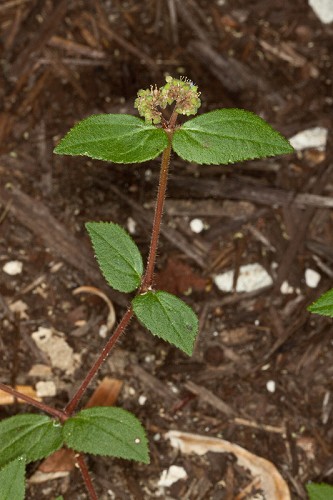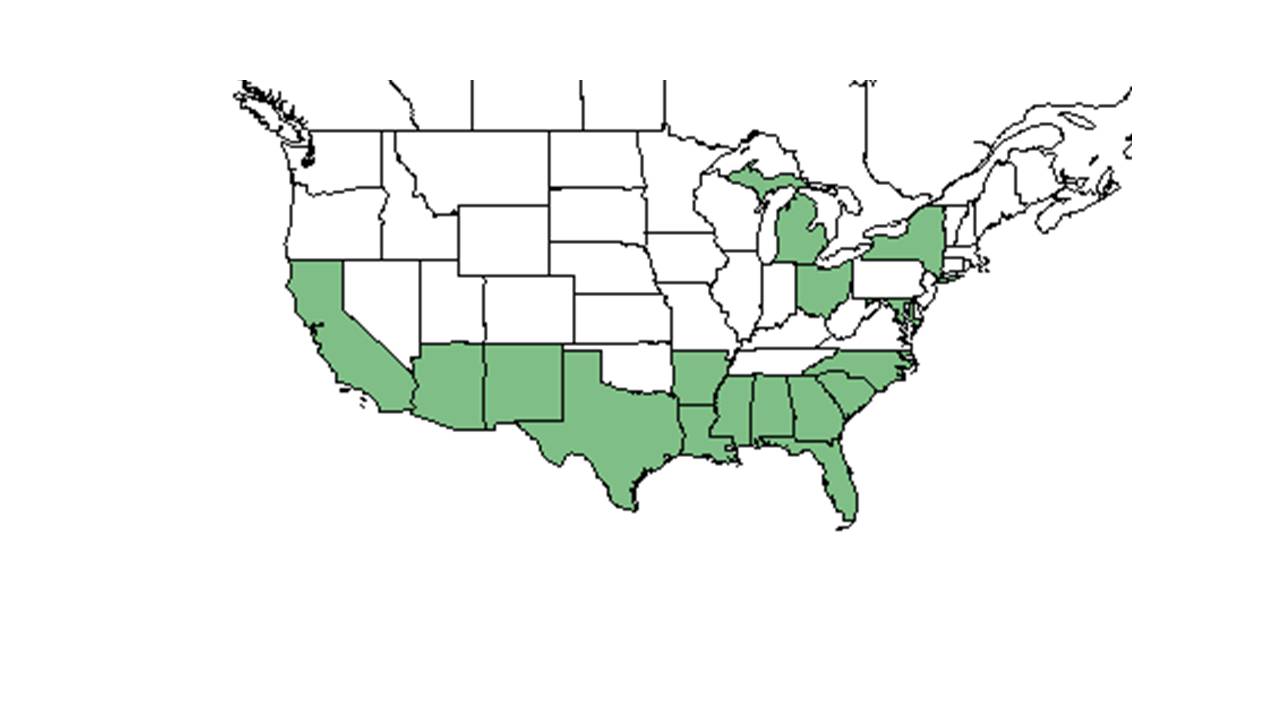Difference between revisions of "Euphorbia hirta"
Emmazeitler (talk | contribs) (→Taxonomic notes) |
|||
| Line 20: | Line 20: | ||
Common name: Pillpod sandmat | Common name: Pillpod sandmat | ||
==Taxonomic notes== | ==Taxonomic notes== | ||
| − | + | Synonyms: ''Chamaesyce hirta'' (Linnaeus) Millspaugh.<ref name="weakley">Weakley, A.S. 2015. Flora of the southern and mid-atlantic states. Working Draft of 21 May 2015. University of North Carolina at Chapel Hill, Chapel Hill, North Carolina.</ref> | |
| + | |||
| + | Varieties: none.<ref name="weakley">Weakley, A.S. 2015. Flora of the southern and mid-atlantic states. Working Draft of 21 May 2015. University of North Carolina at Chapel Hill, Chapel Hill, North Carolina.</ref> | ||
| + | |||
==Description== | ==Description== | ||
<!-- Basic life history facts such as annual/perrenial, monoecious/dioecious, root morphology, seed type, etc. --> | <!-- Basic life history facts such as annual/perrenial, monoecious/dioecious, root morphology, seed type, etc. --> | ||
Revision as of 13:14, 16 September 2020
| Euphorbia hirta | |
|---|---|

| |
| Photo by John R. Gwaltney, Southeastern Flora.com | |
| Scientific classification | |
| Kingdom: | Plantae |
| Division: | Magnoliophyta - Flowering plants |
| Class: | Magnoliopsida – Dicotyledons |
| Order: | Euphorbiales |
| Family: | Euphorbiaceae |
| Genus: | Euphorbia |
| Species: | E. hirta |
| Binomial name | |
| Euphorbia hirta (L.) Millsp. | |

| |
| Natural range of Euphorbia hirta from USDA NRCS Plants Database. | |
Common name: Pillpod sandmat
Contents
Taxonomic notes
Synonyms: Chamaesyce hirta (Linnaeus) Millspaugh.[1]
Varieties: none.[1]
Description
Distribution
Ecology
Habitat
It has been observed to grow in disturbed areas such as lawns, gardens, roadside depressions, vacant lots, fallow fields, and parking lots. It can grow in dry sands and silty loam on mesic areas as well.[2]
Phenology
This species has been observed to flower and fruit from July to August. [3]
Conservation and management
Cultivation and restoration
Photo Gallery
References and notes
- ↑ 1.0 1.1 Weakley, A.S. 2015. Flora of the southern and mid-atlantic states. Working Draft of 21 May 2015. University of North Carolina at Chapel Hill, Chapel Hill, North Carolina.
- ↑ Florida State University Robert K. Godfrey Herbarium database. URL: http://herbarium.bio.fsu.edu. Last accessed: June 2014. Collectors: L. C. Anderson, W. R. Anderson, A. Clewell, K. Blum, M. R. Crosby, J. Duke, J. Dwyer, S. F. da Fonseca, R. K. Godfrey, H. A. Hespenheide, H. S. Irwin, R. Komarek, R. L. Lazor, H. Loftin, T. MacClendon, K. MacClendon, E. Onishi, J. Ramos, R. Reis dos Santos, T. R. Soderstrom, R. Souza, and E. L. Tyson. States and Counties: Florida: Calhoun, Franklin, Jackson, Leon, Liberty, and Wakulla. Georgia: Thomas. Other countries: Brazil, Honduras, Panama, Costa Rica, and Jamaica.
- ↑ Florida State University Robert K. Godfrey Herbarium database. URL: http://herbarium.bio.fsu.edu. Last accessed: June 2014. Collectors: L. C. Anderson, W. R. Anderson, A. Clewell, K. Blum, M. R. Crosby, J. Duke, J. Dwyer, S. F. da Fonseca, R. K. Godfrey, H. A. Hespenheide, H. S. Irwin, R. Komarek, R. L. Lazor, H. Loftin, T. MacClendon, K. MacClendon, E. Onishi, J. Ramos, R. Reis dos Santos, T. R. Soderstrom, R. Souza, and E. L. Tyson. States and Counties: Florida: Calhoun, Franklin, Jackson, Leon, Liberty, and Wakulla. Georgia: Thomas. Other countries: Brazil, Honduras, Panama, Costa Rica, and Jamaica.